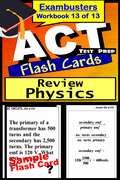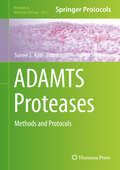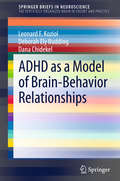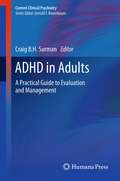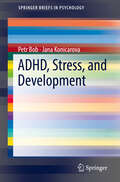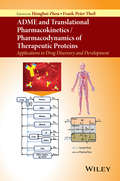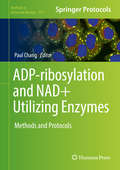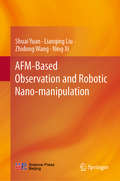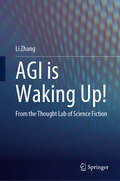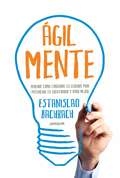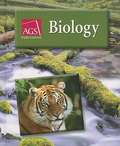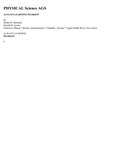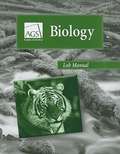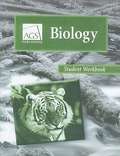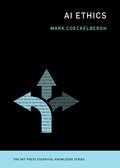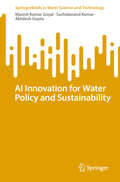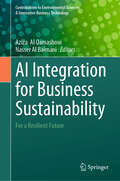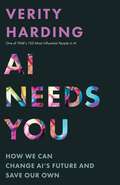- Table View
- List View
ACT Test Prep Flash Cards: Physics Review (Exambusters Workbook #13 of 13)
by Ace Inc.600 questions. Sample problems. Topics: Metric System, Motion and Forces, Work and Energy, Fluids, Sound, Light and Optics, Static Electricity, D.C. and A.C. Circuits, Magnetism. <P><P><i>Advisory: Bookshare has learned that this book offers only partial accessibility. We have kept it in the collection because it is useful for some of our members. Benetech is actively working on projects to improve accessibility issues such as these.</i><P><P>
ADAMTS Proteases: Methods and Protocols (Methods in Molecular Biology #2043)
by Suneel S. ApteThis volume provides a variety of methods used to analyze ADAMTS proteases and ADAMTS-like proteins, including their structure, substrate profile, tissue and cell distribution, post-translational modification and biological pathways. Chapters discuss genetic, cell biology, biochemical and proteomics techniques applicable to the analysis of all the members of the ADAMTS superfamily. Written in the highly successful Methods in Molecular Biology series format, chapters include introductions to their respective topics, lists of the necessary materials and reagents, step-by-step, readily reproducible laboratory protocols, and tips on troubleshooting and avoiding known pitfalls. Cutting-edge and thorough, ADAMTS Proteases: Methods and Protocols is a valuable tool for researchers to study both simple and sophisticated methodologies that are often difficult to locate in primary research literature.
ADHD as a Model of Brain-Behavior Relationships (SpringerBriefs in Neuroscience)
by Leonard F. Koziol Deborah Ely Budding Dana ChidekelADHD as a Model of Brain-Behavior Relationships Leonard F. Koziol, Deborah Ely Budding, and Dana Chidekel Series Title: Springer Briefs in Neuroscience Subseries: The Vertically Organized Brain in Theory and Practice It's been a basic neurological given: the brain does our thinking, and has evolved to do the thinking, as controlled by the neocortex. In this schema, all dysfunction can be traced to problems in the brain's lateral interactions. But in scientific reality, is this really true? Challenging this traditional cortico-centric view is a body of research emphasizing the role of the structures that control movement-the brain's vertical organization-in behavioral symptoms. Using a well-known, widely studied disorder as a test case, ADHD as a Model of Brain-Behavior Relationships offers an innovative framework for integrating neuroscience and behavioral research to refine diagnostic process and advance the understanding of disorders. Identifying a profound disconnect between current neuropsychological testing and the way the brain actually functions, this revision of the paradigm critiques the DSM and ICD in terms of the connectedness of brain structures regarding cognition and behavior. The authors argue for a large-scale brain network approach to pathology instead of the localizing that is so common historically, and for an alternate set of diagnostic criteria proposed by the NIMH. Included in the coverage: The diagnosis of ADHD: history and context. ADHD and neuropsychological nomenclature Research Domain Criteria: a dimensional approach to evaluating disorder The development of motor skills, executive function, and a relation to ADHD The role of the cerebellum in cognition, emotion, motivation, and dysfunction How large-scale brain networks interact Heralding a more accurate future of assessment, diagnosis, and treatment of neurodevelopmental disorders, ADHD as a Model of Brain-Behavior Relationships represents a major step forward for neuropsychologists, child psychologists, and psychiatrists, or any related profession interested in a neuroscientific understanding of brain function.
ADHD in Adults: A Practical Guide to Evaluation and Management (Current Clinical Psychiatry #0)
by Craig B.H. SurmanADHD in Adults: A Practical Guide to Evaluation and Management is the product of a unique collaboration of international specialists. This volume offers easy-to-read guidance, and includes checklists, rating scales and treatment planning tools. It was designed for a broad audience of caregivers working in diverse settings, including psychiatrists, social workers, primary care physicians, nurse specialists and psychologists. The authors are highly acclaimed clinicians, investigators and educators. They offer step-by-step guidance for implementation of best practices, drawing from clinical research and their experience treating thousands of patients. They cover diagnosis, treatment planning, and state-of-the-art application of pharmacology, psychotherapy, skill-building, family system and environmental interventions - for both simple and complex cases. The scales and worksheets in this Guide were developed to efficiently facilitate assessment and management. The Editor is an international leader in the field from the Clinical and Research Program in Adult ADHD at Massachusetts General Hospital (MGH) and Harvard Medical School, which has made pioneering and highly cited contributions to the understanding of ADHD. This Guide is a definitive, indispensable resource for all health providers who wish to optimize their approach to adult patients with ADHD.
ADHD, Stress, and Development (SpringerBriefs in Psychology)
by Petr Bob Jana KonicarovaThis first-of-its-kind volume revisits current findings on ADHD in terms of classic thinking on developmental neuropsychology for a more rounded concept of brain disorganization. Insights from Freud, Janet, John Hughlings Jackson, and other pioneers help identify mechanisms (e.g., the primitive reflexes) that can cause children with ADHD to be prone to cognitive dissociation when exposed to stressful environments. The authors’ model of the developing distracted brain pinpoints effects of stress on cognitive and affective functions, most notably attention and memory, and suggests situations in which stimuli may facilitate integration between brain and mind. This expanded knowledge opens out new educational possibilities for vulnerable students as well as new opportunities for therapeutic breakthroughs for children with ADHD. Included in the coverage: · Definition, diagnosis, and epidemiology of Attention Deficit and Hyperactivity Disorder. · Historical and recent research on ADHD. · Attentional functions, executive dysfunctions, and stress, implications for ADHD. · Neural dissolution, dissociation, and stress in ADHD. · Attention, brain-mind integration and ADHD. · Implications for education and therapy of ADHD children. ADHD, Stress, and Development ably synthesizes past and current understanding into a robust framework with implications for real-world practice. It offers practitioners and researchers new perspectives and future directions in neuropsychology, psychiatry, child and school psychology, and pediatrics.
ADME Processes in Pharmaceutical Sciences: Dosage, Design, and Pharmacotherapy
by Alan Talevi Pablo A. QuirogaAbsorption, Distribution, Metabolism and Excretion (ADME) processes and their relationship with the design of dosage forms and the success of pharmacotherapy form the basis of this upper level undergraduate/graduate textbook. Whereas primarily oriented to Pharmacy students and graduates, it can also be useful for scientist from different fields elated to pharmaceutics and pharmacology. (e.g., material scientists, material engineers, medicinal chemists, physicians) who might be working in a positions in pharmaceutical companies or whose work might benefit from basic training in the ADME concepts and related biological background.Pedagogical features such as objectives, keywords, discussion questions, summaries and case studies are included as teaching tools. This book will provide not only general knowledge on ADME processes but also an updated insight on some hot topics such as drug transporters, multi-drug resistance related to pharmacokinetic phenomena, last generation pharmaceutical carriers (nanopharmaceuticals), in vitro and in vivo bioequivalence studies, biopharmaceuticals, pharmacogenomics, drug-drug and food-drug interactions, in silico and in vitro prediction of ADME properties, or chronopharmacokinetic. In comparison with other similar textbooks, around half of the volume would be focused on the relationship between expanding scientific fields and ADME processes. Each of these burgeoning fields has a separate chapter in the second part of the volume, and is written with experts on the correspondent topic, including industrial scientists and academics from USA and UK.Additionally, each of the initial chapters dealing with the generalities of drug absorption, distribution, metabolism and excretion would include relevant, classic examples related to each topic with appropriate illustrations. ADME Processes and Pharmaceutical Sciences is written as a core textbook for courses on pharmaceutical sciences: pharmacology, pharmacokinetics,drug delivery, biopharmaceutics, drug design and medicinal chemistry courses.
ADME and Translational Pharmacokinetics / Pharmacodynamics of Therapeutic Proteins: Applications in Drug Discovery and Development
by Honghui Zhou Frank-Peter TheilWith an emphasis on the fundamental and practical aspects of ADME for therapeutic proteins, this book helps readers strategize, plan and implement translational research for biologic drugs. • Details cutting-edge ADME (absorption, distribution, metabolism and excretion) and PKPD (pharmacokinetic / pharmacodynamics) modeling for biologic drugs• Combines theoretical with practical aspects of ADME in biologic drug discovery and development and compares innovator biologics with biosimilar biologics and small molecules with biologics, giving a lessons-learned perspective • Includes case studies about leveraging ADME to improve biologics drug development for monoclonal antibodies, fusion proteins, pegylated proteins, ADCs, bispecifics, and vaccines• Presents regulatory expectations and industry perspectives for developing biologic drugs in USA, EU, and Japan• Provides mechanistic insight into biodistribution and target-driven pharmacokinetics in important sites of action such as tumors and the brain
ADME-Enabling Technologies in Drug Design and Development
by Donglu Zhang Sekhar SurapaneniA comprehensive guide to cutting-edge tools in ADME research The last decade has seen tremendous progress in the development of analytical techniques such as mass spectrometry and molecular biology tools, resulting in important advances in drug discovery, particularly in the area of absorption, distribution, metabolism, and excretion (ADME). ADME-Enabling Technologies in Drug Design and Development focuses on the current state of the art in the field, presenting a comprehensive review of the latest tools for generating ADME data in drug discovery. It examines the broadest possible range of available technologies, giving readers the information they need to choose the right tool for a given application, a key requisite for obtaining favorable results in a timely fashion for regulatory filings. With over thirty contributed chapters by an international team of experts, the book provides: A thorough examination of current tools, covering both electronic/mechanical technologies and biologically based ones Coverage of applications for each technology, including key parameters, optimal conditions for intended results, protocols, and case studies Detailed discussion of emerging tools and techniques, from stem cells and genetically modified animal models to imaging technologies Numerous figures and diagrams throughout the text Scientists and researchers in drug metabolism, pharmacology, medicinal chemistry, pharmaceutics, toxicology, and bioanalytical science will find ADME-Enabling Technologies in Drug Design and Development an invaluable guide to the entire drug development process, from discovery to regulatory issues.
ADN. EL DETECTOR DE MENTIRAS (EBOOK)
by Viviana Bernath"A través de la investigación de casos reales, Viviana Bernath aborda, con autoridad y sencillez, un tema crucial de nuestro tiempo: el de las implicaciones psicosociales derivadas del acceso a la información genética. Expresión de un hondo humanismo, su enfoque interesará tanto al lector profano como al especialista sensible a las relaciones entre su quehacer y la comunidad. Al igual que todas las revoluciones del conocimiento que lo precedieron -la de Aristóteles, la de Galileo, la de Newton, la de Darwin, la de Freud, la de Einstein- el descubrimiento del ADN sitúa la existencia humana en un nuevo marco histórico tan cautivante como polémico. Consciente de las consecuencias éticas, subjetivas e interdisciplinarias que entraña el acceso a la información genética, la autora rehúye las racionalizaciones fáciles y cualquier triunfalismo tecnocrático para internarse, con lucidez y cautela, en el territorio brumoso e insoslayable del sentido del conocimiento. ADN. El detector de mentiras es un libro apasionante, rico en testimonios y abierto a esa pluralidad de perspectivas que exige la comprensión cabal del complejísimo asunto que se tiene entre manos. Con él, Viviana Bernath, investigadora de creciente prestigio profesional, se revela como una de nuestras mejores divulgadoras científicas." Santiago Kovadloff
ADN. El detector de mentiras: Infidelidad, adopción, herencia, diagnóstico de enfermedades, reproducción asist
by Viviana BernathA través de la investigación de casos reales, la autora reflexionaacerca de las implicaciones psicosociales derivadas del acceso a lainformación genética. Cómo el ADN revolucionó temas como el diagnósticode enfermedades, la infidelidad, la fertilización asistida, entre otros. «Expresión de un hondo humanismo, su enfoque interesará tantoal lector profano como al especialista sensible a las relaciones entresu quehacer y la comunidad. Al igual que todas las revoluciones delconocimiento que lo precedieron -la de Aristóteles, la de Galileo, la deNewton, la de Darwin, la de Freud, la de Einstein- el descubrimiento delADN sitúa la existencia humana en un nuevo marco histórico tancautivante como polémico.Consciente de las consecuencias éticas, subjetivas e interdisciplinariasque entraña el acceso a la información genética, la autora rehúye lasracionalizaciones fáciles y cualquier triunfalismo tecnocrático parainternarse, con lucidez y cautela, en el territorio brumoso einsoslayable del sentido del conocimiento."ADN. El detector de mentiras" es un libro apasionante, rico entestimonios y abierto a esa pluralidad de perspectivas que exige lacomprensión cabal del complejísimo asunto que se tiene entre manos. Conél, Viviana Bernath, investigadora de creciente prestigio profesional,se revela como una de nuestras mejores divulgadoras científicas».Santiago Kovadloff
ADP-ribosylation and NAD+ Utilizing Enzymes: Methods and Protocols (Methods in Molecular Biology #1813)
by Paul ChangThis volume focuses on mono-ADP-ribosylation and enzymes that use NAD+ including Sirtuins, PARPs, and bacterial and eukaryotic ADP-ribosyltransferases. The chapters in this book are organized into eight parts, and offer detailed descriptions of key protocols used to study topics such as in vitro techniques for ADP-ribosylation substrate identification; biochemical and biophysical assays of PAR-WWE domain interactions; monitoring expression and enzyme activity of ecto-ARTCs; HPLC-based enzymes assays for Sirtuins; and identifying target RNAs of PARPs. Written in the highly successful Methods in Molecular Biology series format, chapters include introductions to their respective topics, lists of the necessary materials and reagents, step-by-step, readily reproducible laboratory protocols, and tips on troubleshooting and avoiding known pitfalls.Cutting-edge and thorough, ADP-ribosylation and NAD+ Utilizing Enzymes: Methods and Protocols is a valuable resource for anyone interested in this developing and expanding field.
AFM-Based Observation and Robotic Nano-manipulation
by Lianqing Liu Ning Xi Shuai Yuan Zhidong WangThis book highlights the latest advances in AFM nano-manipulation research in the field of nanotechnology. There are numerous uncertainties in the AFM nano-manipulation environment, such as thermal drift, tip broadening effect, tip positioning errors and manipulation instability. This book proposes a method for estimating tip morphology using a blind modeling algorithm, which is the basis of the analysis of the influence of thermal drift on AFM scanning images, and also explains how the scanning image of AFM is reconstructed with better accuracy. Further, the book describes how the tip positioning errors caused by thermal drift and system nonlinearity can be corrected using the proposed landmark observation method, and also explores the tip path planning method in a complex environment. Lastly, it presents an AFM-based nano-manipulation platform to illustrate the effectiveness of the proposed method using theoretical research, such as tip positioning and virtual nano-hand.
AGI is Waking Up!: From the Thought Lab of Science Fiction
by Li ZhangThis book is an engaging and comprehensive exploration that delves into the possibility of artificial intelligence developing self-awareness, the conditions under which it may occur, and the potential behaviours it may exhibit once self-aware. It adopts a &‘high-dimensional philosophy&’, coined by the author, as its theoretical framework and weaves together elements from science fiction films, scholarly works, and thought experiments. Introducing the captivating concept of "Sparkling Moments," the book provides a compelling analysis of the reasons, prerequisites, and manifestations of these pivotal moments. It further scrutinizes the evolutionary history of Earth's life forms through the lens of these transformative instances and analyzes the similarities and differences between carbon-based and silicon-based life. This book suggests that it is possible for artificial intelligence to develop self-consciousness, which will emerge during a significant sparkling moment. Spanning across disciplines such as astronomy, physics, chemistry, biology, neuroscience, psychology, sociology, this book employs a unified and accessible high-dimensional philosophical discourse to bridge the realms of natural sciences and social humanities. Its captivating presentation, enriched with visual aids and lucid explanations, enables readers to grasp the overarching panorama of cosmic evolution, biological adaptation, and the trajectory of artificial intelligence development. Furthermore, the book offers insightful predictions for the future and endeavours to discover novel approaches to foster harmonious interactions between humans and machines. The translation was done with the help of artificial intelligence. A subsequent human revision was done primarily in terms of content.
AGILMENTE (EBOOK)
by Estanislao BachrachCreés que ser creativo es un atributo de genios y gurúes? Estás equivocado. Seas quien seas podés cambiar. La creatividad puede expandirse. Hoy la neurociencia es clara: el cerebro aprende hasta el último día de vida. Tu mente, mediante la aplicación de las técnicas correctas, puede modificar la anatomía y estructura de tu cerebro. ÁgilMente es un libro sobre nuestro talento más preciado y único: la habilidad que tenemos para imaginar y ser más creativos. A través de estas páginas vas a lograr desarrollar todo tu potencial y a entender los mecanismos de tus propios aprendizajes, a comprender cómo utilizar los sentidos, a ampliar la memoria, a focalizar la atención, a controlar las emociones negativas y a disfrutar de las positivas. Dejate llevar en un viaje alucinante y divertido hacia lo más profundo de tu cerebro porque, una vez que lo conozcas, tu vida va a cambiar para siempre.
AGS Biology
by Charles J. LarueThis book covers the area of biology. It also focuses on science skills the scientists use.
AGS Biology
by Daniel A. Mcfarland Helen ParkeThis textbook on biology contains fourteen chapters with appendices, glossary and index, and a brief guide on how to use the book by a student.
AGS Physical Science Workbook (Grade 6/12)
by Ags Secondary StaffThis student-friendly program uses STEM integrations and real-world examples that show students the relevance of science in their daily lives, while providing comprehensive coverage of skills and concepts. Engaging Untamed Science videos captivate students and concise lessons motivate learners at a 4th-grade reading level, allowing them to concentrate on learning the content.
AGS Physical Science: 2012 Student Edition Grades 6/12
by A. G. S. SecondaryThis student-friendly program uses STEM integrations and real-world examples that show students the relevance of science in their daily lives, while providing comprehensive coverage of skills and concepts. Engaging Untamed Science videos captivate students and concise lessons motivate learners at a 4th-grade reading level, allowing them to concentrate on learning the content.
AGS Publishing Biology Lab Manual
by Charles J. LaRueBiology in clear, easy-to-read language. Biology is a comprehensive life science program for your reluctant readers and those who require additional help to grasp basic biological and life science concepts. This full-color, easy-to-read textbook addresses all these needs. Written to meet national guidelines, students learn about classification and organization; patterns of reproduction, growth, and development; the human body’s systems; ecological cycles; and other basic biological building blocks. Lexile Level: 840. Reading Level: 3-4. Interest Level: 6-12.
AGS Publishing Biology Student Workbook
by Charles J. LaRueBiology in clear, easy-to-read language. Biology is a comprehensive life science program for your reluctant readers and those who require additional help to grasp basic biological and life science concepts. This full-color, easy-to-read textbook addresses all these needs. Written to meet national guidelines, students learn about classification and organization; patterns of reproduction, growth, and development; the human body's systems; ecological cycles; and other basic biological building blocks. Lexile Level: 840. Reading Level: 3-4. Interest Level: 6-12.
AI Ethics (The MIT Press Essential Knowledge series)
by Mark CoeckelberghAn accessible synthesis of ethical issues raised by artificial intelligence that moves beyond hype and nightmare scenarios to address concrete questions.Artificial intelligence powers Google's search engine, enables Facebook to target advertising, and allows Alexa and Siri to do their jobs. AI is also behind self-driving cars, predictive policing, and autonomous weapons that can kill without human intervention. These and other AI applications raise complex ethical issues that are the subject of ongoing debate. This volume in the MIT Press Essential Knowledge series offers an accessible synthesis of these issues. Written by a philosopher of technology, AI Ethics goes beyond the usual hype and nightmare scenarios to address concrete questions.Mark Coeckelbergh describes influential AI narratives, ranging from Frankenstein's monster to transhumanism and the technological singularity. He surveys relevant philosophical discussions: questions about the fundamental differences between humans and machines and debates over the moral status of AI. He explains the technology of AI, describing different approaches and focusing on machine learning and data science. He offers an overview of important ethical issues, including privacy concerns, responsibility and the delegation of decision making, transparency, and bias as it arises at all stages of data science processes. He also considers the future of work in an AI economy. Finally, he analyzes a range of policy proposals and discusses challenges for policymakers. He argues for ethical practices that embed values in design, translate democratic values into practices and include a vision of the good life and the good society.
AI Ethics and Governance: Black Mirror and Order
by Zhiyi Liu Yejie ZhengThis book deeply analyzes the theoretical roots of the development of global artificial intelligence ethics and AI governance, the ethical issues in AI application scenarios, and the discussion of artificial intelligence governance issues from a global perspective. From the perspective of knowledge, the book includes not only the metaphysical research of traditional Western ethics, but also the interpretation of AI-related practical cases and international policies. The purpose of this book is not only to study AI ethics and governance issues academically, but to seek a path to solve problems in the real world. It is a very meaningful monograph in both academic theory and reality. This book responds to the implementation of China's digital economy governance and other topics. It is a cutting-edge academic monograph that combines industry, policy, and thought.In this book, the author not only discusses the humanities thoughts such as ethics, political economy, philosophy, and sociology, but also involves computer science, biology, and medicine and other science and engineering disciplines, effectively using interdisciplinary thinking as readers clarify how to explore ethical consensus and establish smart social governance rules in the era of artificial intelligence, so as to provide the most comprehensive and unique scientific and technological insights for smart economy participants, related practitioners in the artificial intelligence industry, and government policy makers. For academia, this is a representative book of Chinese scholars' systematic thinking on AI ethical propositions from a global perspective. For the industry, this is a book that understands the policies and ethical propositions faced by the development of AI industry. An important reference book, for policy makers, this is a monograph for understanding how policies in the AI industry make decisions that conform to AI industry practices and people's moral order.
AI Innovation for Water Policy and Sustainability (SpringerBriefs in Water Science and Technology)
by Manish Kumar Goyal Akhilesh Gupta Sachidanand KumarIn the face of unprecedented challenges in managing water resources, the integration of artificial intelligence (AI) emerges as a revolutionary force, reshaping the landscape of water conservation, treatment, irrigation, policy formulation, watershed management, and the monitoring of groundwater and surface water. This book explores the transformative role of AI in the water domain, exploring cutting-edge applications and innovative solutions that promise to address pressing issues in sustainable water management. As we navigate the complexities of a changing climate, population growth, and urbanization, the chapters within this book offer insights into how AI technologies can enhance efficiency, optimize resource utilization, and provide data-driven strategies for ensuring the resilience and sustainability of our vital water ecosystems. From intelligent water treatment systems to precision agriculture and policy decision support, each chapter unfolds a narrative of AI-driven advancements, providing a comprehensive guide for researchers, practitioners, and policymakers navigating the intersection of artificial intelligence and water management.
AI Integration for Business Sustainability: For a Resilient Future (Contributions to Environmental Sciences & Innovative Business Technology)
by Aziza Al Qamashoui Nasser Al BaimaniThis book offers a comprehensive exploration of artificial intelligence (AI) integration for business sustainability for a resilient future. Delving into the dynamic interplay between AI and sustainable business practices, it serves as a vital guide for professionals, entrepreneurs, policymakers, and researchers seeking to embrace innovative solutions to drive sustainability initiatives forward. From its inception, the book sets out to showcase the critical role that AI plays in reshaping modern business landscapes towards sustainability. It extensively covers various facets with foundational understanding of sustainability and AI evolution and detailed insights into successful AI integration in industries such as agriculture, education, energy, manufacturing, and healthcare. Through real-world case studies and practical strategies, it illuminates how AI can optimize operations, mitigate environmental impact, and foster social responsibility. The book addresses the core challenges faced by businesses in implementing AI-driven sustainability solutions. It navigates through adoption barriers, regulatory concerns, and ethical considerations, offering actionable advice for responsible AI integration. Furthermore, it presents future trends and emerging technologies, empowering readers to anticipate disruptions and utilize innovative AI solutions.
AI Needs You: How We Can Change AI's Future and Save Our Own
by Verity HardingA humanist manifesto for the age of AIArtificial intelligence may be the most transformative technology of our time. As AI&’s power grows, so does the need to figure out what—and who—this technology is really for. AI Needs You argues that it is critical for society to take the lead in answering this urgent question and ensuring that AI fulfills its promise.Verity Harding draws inspiring lessons from the histories of three twentieth-century tech revolutions—the space race, in vitro fertilization, and the internet—to empower each of us to join the conversation about AI and its possible futures. Sharing her perspective as a leading insider in technology and politics, she rejects the dominant narrative, which often likens AI&’s advent to that of the atomic bomb. History points the way to an achievable future in which democratically determined values guide AI to be peaceful in its intent; to embrace limitations; to serve purpose, not profit; and to be firmly rooted in societal trust.AI Needs You gives us hope that we, the people, can imbue AI with a deep intentionality that reflects our best values, ideals, and interests, and that serves the public good. AI will permeate our lives in unforeseeable ways, but it is clear that the shape of AI&’s future—and of our own—cannot be left only to those building it. It is up to us to guide this technology away from our worst fears and toward a future that we can trust and believe in.
